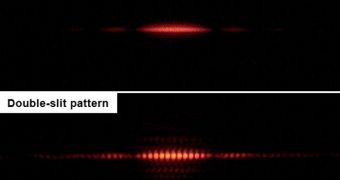Physicists from the University of Vienna in Austria announce the completion of the largest iteration of the famous double-slit experiment (DSE). They managed to use very massive molecules, containing either 58 or 114 atoms, while replicating the centuries-old study.
The DSE represents one of the most significant foundations for quantum mechanics today. It was first conducted in the early 1800s, by English scientist Thomas Young. His goal was to determine whether light is made up of particles or waves.
He determined that photons act like both particle and wave, a discovery that contributed to the development of principles such as quantum entanglement and superposition. The latter holds that a particle can exist in two states at the same time (i.e. particle and wave, as opposed to particle or wave).
What the UV team did recently was replicate Young's experiment using not photons, but very large molecules. Researchers were puzzled when they discovered that the same familiar interference patterns were observed with large-scale molecules, and not exclusively with subatomic particles.
“In a way it's a little bit surprising, because these are highly complex and also flexible molecules; they change their shape while they're flying through the apparatus,” expert Markus Arndt explains.
“If you talk to the community, maybe 50 percent would say this is normal because it's quantum physics, and the other 50 percent would really scratch their heads because it's quantum physics,” adds the scientist, who was one of the leaders on the new project.
Historically speaking, Young's experiment showed that light is a wave, a finding out of tune with 17th and 18th century beliefs. But Albert Einstein showed in 1905 that light is also a particle, and this is how the notion of wave-particle duality was born, LiveScience reports.
In 1961, German physicist Claus Jönsson discovered that the interference patterns caused by light passing through the DSE did not belong exclusively to photons, but could be achieved using electrons as well. This again caused a revolution in physics.
“Seeing the two-slit experiment is like watching a total solar eclipse for the first time: A primitive thrill passes through you and the little hairs on your arms stand up. You think this particle-wave thing is really true and the foundations of your knowledge shift and sway,” comments Alison Campbell.
She holds an appointment as an astronomer at the St. Andrews University, in Scotland. Details of the new study appear in the March 25 online issue of the top scientific journal Nature Nanotechnology.

 14 DAY TRIAL //
14 DAY TRIAL //